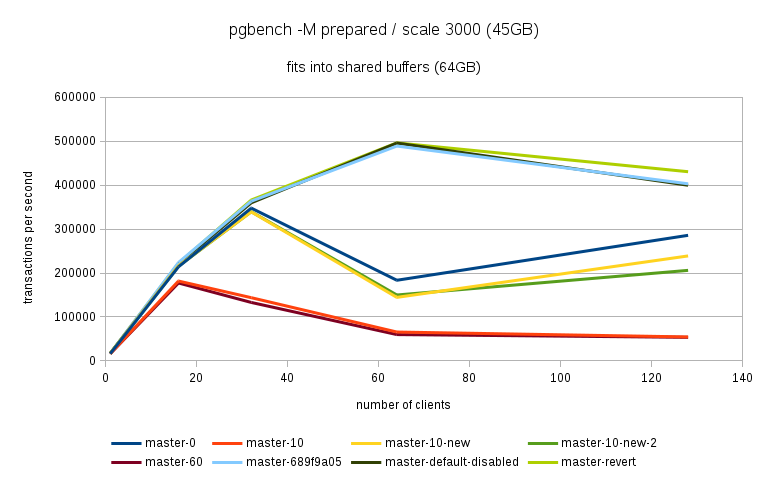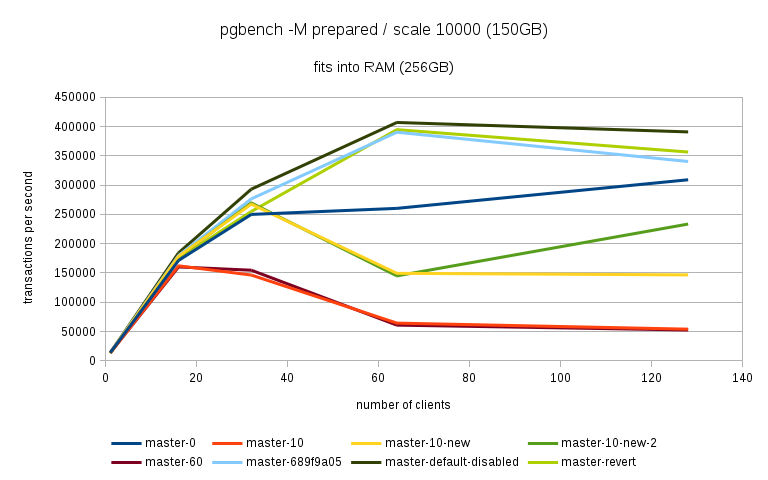Re: what to revert
| From: | Tomas Vondra <tomas(dot)vondra(at)2ndquadrant(dot)com> |
|---|---|
| To: | Andres Freund <andres(at)anarazel(dot)de> |
| Cc: | pgsql-hackers(at)postgresql(dot)org |
| Subject: | Re: what to revert |
| Date: | 2016-05-10 02:01:58 |
| Message-ID: | e17a7535-09b8-2273-0f7c-2d368390b0ed@2ndquadrant.com |
| Views: | Raw Message | Whole Thread | Download mbox | Resend email |
| Thread: | |
| Lists: | pgsql-hackers |
Hi,
Over the past few days I've been running benchmarks on a fairly large
NUMA box (4 sockets, 32 cores / 64 with HR, 256GB of RAM) to see the
impact of the 'snapshot too old' - both when disabled and enabled with
various values in the old_snapshot_threshold GUC.
The full results are available here:
https://drive.google.com/folderview?id=0BzigUP2Fn0XbR1dyOFA3dUxRaUU
but let me explain how the benchmark was done and present a brief
summary of the results as I understand them.
The benchmark is a simple read-only pgbench with prepared statements,
i.e. doing something like this:
pgbench -S -M prepared -j N -c N
This was done on three datasets with different scales - small (100),
medium (3000) and large (10000). All of this fits into RAM, the two
smaller data sets fit into shared_buffers.
For each scale, the benchmark was run for 1, 16, 32, 64 and 128 clients,
5 runs for each client count, 5 minutes each. But only after a 2-hour
warmup with 128 clients.
So essentially something like this:
for s in 100 3000 10000; do
... init + warmup
for r in 1 2 3 4 5; do
for c in 1 16 32 64 128; do
pgbench -S -M prepared ...
done
done
done
The full results are available in the .tgz archive (as produced by
run.sh included in it). The old_snap.csv contains just the extracted
results, and there's also an ODS with some charts.
The initial set of test was run on 4bbc1a7e which was the last commit in
master when the benchmark was started. Then I've tested with 689f9a05
which is the last commit before the 'snapshot too old' got introduced,
and 91fd1df4 which is the current master, including a commit that should
improve performance in some cases.
So in total there are data for these combinations
master-0 - 4bbc1a7e + old_snapshot_threshold=0
master-10 - 4bbc1a7e + old_snapshot_threshold=10
master-10-new - 91fd1df4 + old_snapshot_threshold=10
master-10-new-2 - 91fd1df4 + old_snapshot_threshold=10 (rerun)
master-60 - 4bbc1a7e + old_snapshot_threshold=60
master-689f9a05 - before the feature was added
master-default-disabled - 4bbc1a7e + old_snapshot_threshold=-1
master-revert - 4bbc1a7e + revert.patch (reverts the feature)
The results (average of the 5 runs) look like this (also see the charts
attached to this post):
scale=100
---------
dataset 1 16 32 64 128
master-0 18118 227615 370336 176435 229796
master-10 17741 186197 161655 66681 54977
master-10-new 18572 229685 351378 141624 183029
master-10-new-2 18366 228256 353420 148061 197953
master-60 17691 177053 137311 59508 53325
master-689f9a05 18630 237123 389782 519069 444732
master-disabled 17727 230818 386112 524981 440043
master-revert 18584 237383 390779 531075 457005
scale=3000
----------
dataset 1 16 32 64 128
master-0 16480 214081 347689 183451 285729
master-10 16390 181683 143847 65614 54499
master-10-new 16821 216562 339106 144488 238851
master-10-new-2 17121 215423 339424 149910 206001
master-60 16372 177228 133013 59861 53599
master-689f9a05 16945 223894 363393 488892 402938
master-disabled 16635 220064 359686 495642 399728
master-revert 16963 221884 366086 496107 430518
scale=10000
-----------
dataset 1 16 32 64 128
master-0 13954 171378 249923 260291 309065
master-10 13513 162214 146458 64457 54159
master-10-new 13776 178255 267475 149335 146706
master-10-new-2 13188 176799 269629 145049 233515
master-60 14102 160247 154704 61015 52711
master-689f9a05 13896 179688 276487 390220 340206
master-disabled 13939 184222 293032 406846 390739
master-revert 12971 174562 254986 394569 356436
A few initial observations:
* The results are a bit noisy, but I think in general this shows that
for certain cases there's a clearly measurable difference (up to 5%)
between the "disabled" and "reverted" cases. This is particularly
visible on the smallest data set.
* What's fairly strange is that on the largest dataset (scale 10000),
the "disabled" case is actually consistently faster than "reverted" -
that seems a bit suspicious, I think. It's possible that I did the
revert wrong, though - the revert.patch is included in the tgz. This is
why I also tested 689f9a05, but that's also slower than "disabled".
* The performance impact with the feature enabled seems rather
significant, especially once you exceed the number of physical cores (32
in this case). Then the drop is pretty clear - often ~50% or more.
* 7e3da1c4 claims to bring the performance within 5% of the disabled
case, but that seems not to be the case. What it however does is
bringing the 'non-immediate' cases close to the immediate ones (before
the performance drop came much sooner in these cases - at 16 clients).
* It's also seems to me the feature greatly amplifies the variability of
the results, somehow. It's not uncommon to see results like this:
master-10-new-2 235516 331976 133316 155563 133396
where after the first runs (already fairly variable) the performance
tanks to ~50%. This happens particularly with higher client counts,
otherwise the max-min is within ~5% of the max. There are a few cases
where this happens without the feature (i.e. old master, reverted or
disabled), but it's usually much smaller than with it enabled
(immediate, 10 or 60). See the 'summary' sheet in the ODS spreadsheet.
I don't know what's the problem here - at first I thought that maybe
something else was running on the machine, or that anti-wraparound
autovacuum kicked in, but that seems not to be the case. There's nothing
like that in the postgres log (also included in the .tgz).
And the shell script interleaves runs for different client counts, so
another process running on the system would affect the surrounding runs
too (but that's not the case).
regards
--
Tomas Vondra http://www.2ndQuadrant.com
PostgreSQL Development, 24x7 Support, Remote DBA, Training & Services
| Attachment | Content-Type | Size |
|---|---|---|
| old_snap.ods | application/vnd.oasis.opendocument.spreadsheet | 54.8 KB |

|
image/png | 48.9 KB |

|
image/png | 46.7 KB |

|
image/png | 47.0 KB |
In response to
- Re: what to revert at 2016-05-07 00:54:18 from Tomas Vondra
Responses
- Re: what to revert at 2016-05-10 08:29:15 from Kevin Grittner
Browse pgsql-hackers by date
| From | Date | Subject | |
|---|---|---|---|
| Next Message | Craig Ringer | 2016-05-10 02:49:43 | Re: Stopping logical replication protocol |
| Previous Message | Craig Ringer | 2016-05-10 01:50:35 | Re: Stopping logical replication protocol |